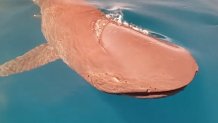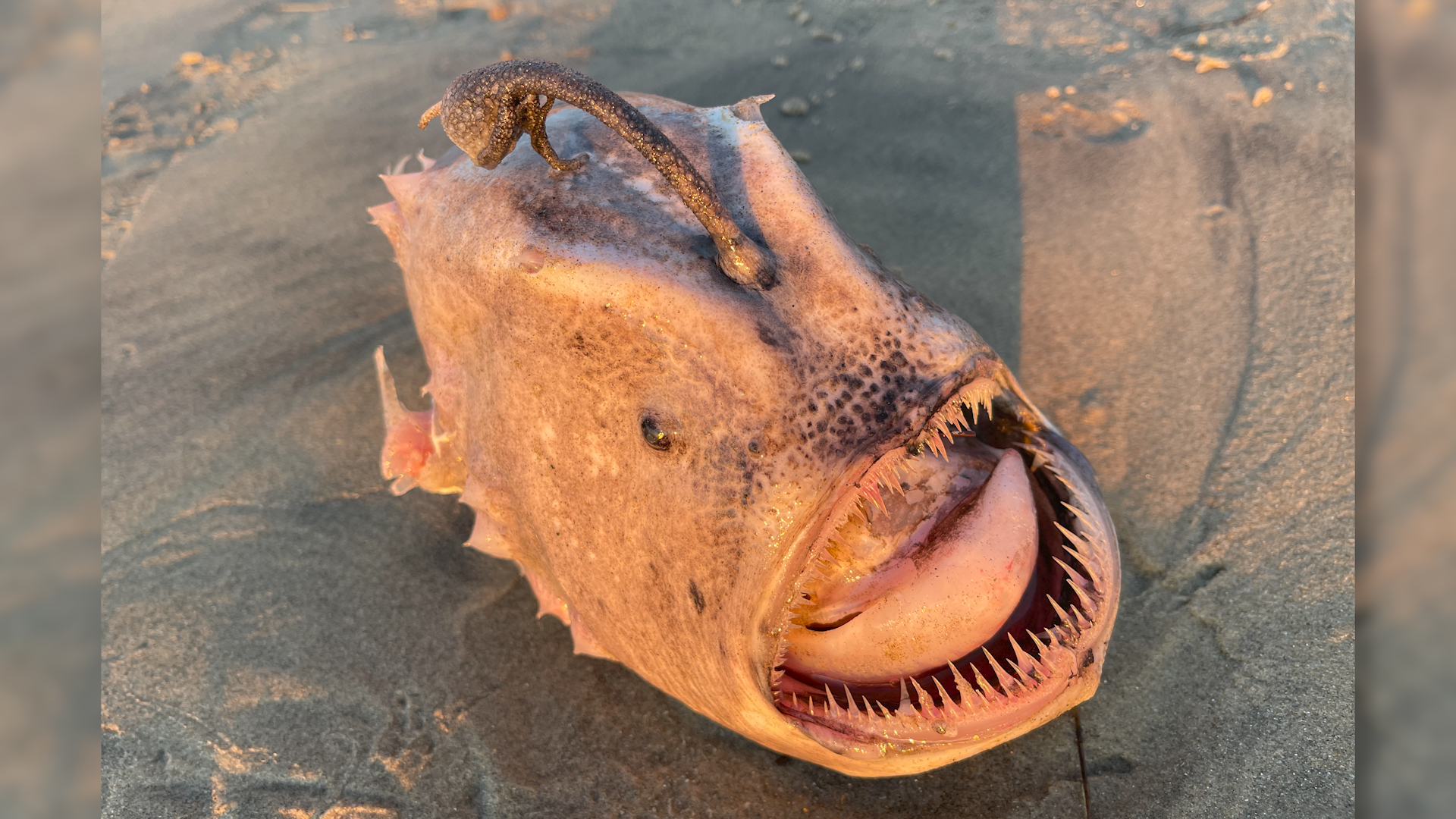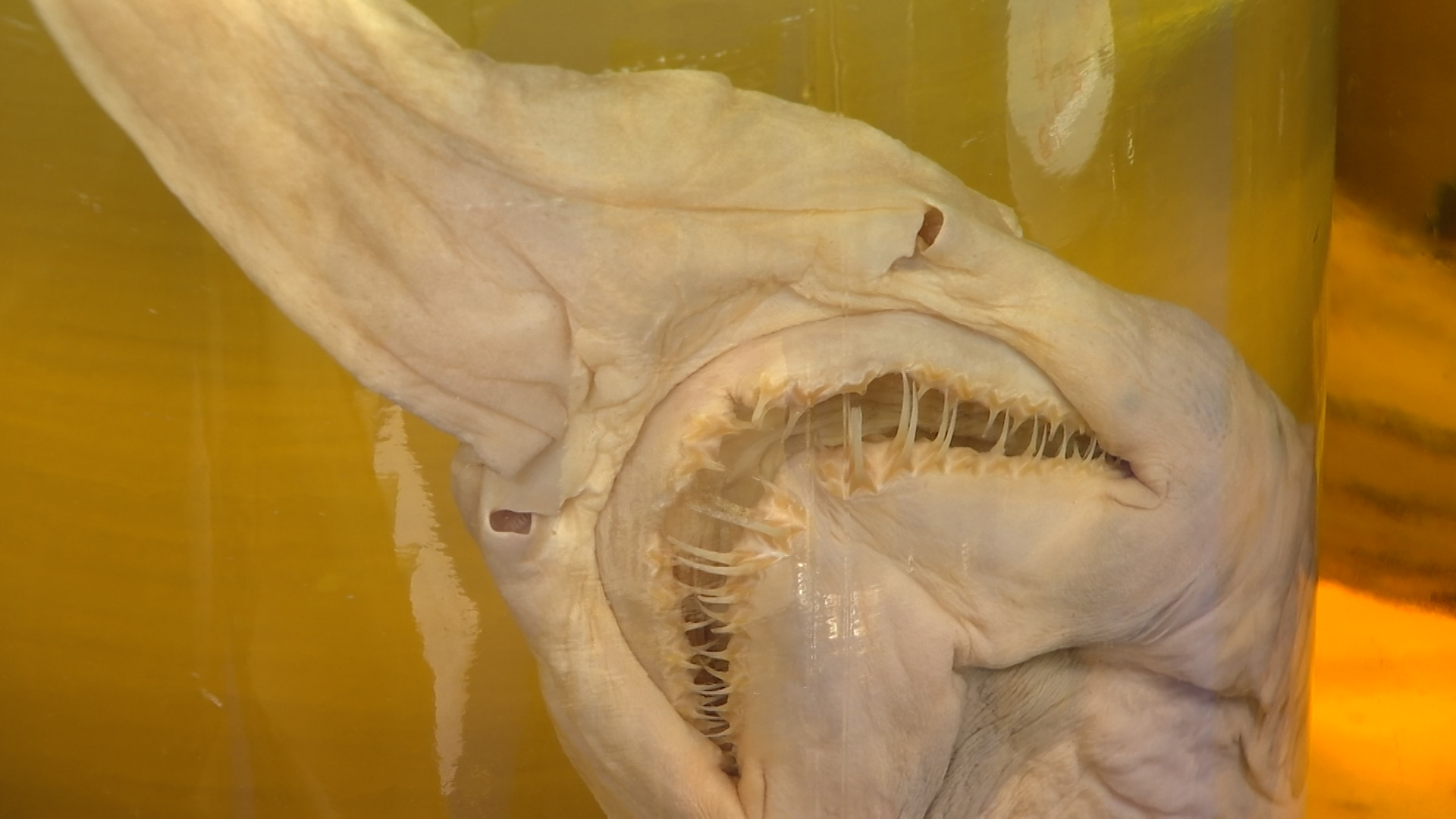Imagine it: You're miles and miles off the coast of San Diego, it's a sunny, singular day, with a glassy ocean and hyper cerulean skies. The deep blue of the water is uninterrupted as far as your sight will carry you.
Until you see it, them, fins, sharks, sloooooow sharks, two of them, and they're massive, prehistoric-like in the lethargic prehistoric sweep of their fins. One — both? — have been gnawed on by something. Fins, or pieces of fins are missing, old wounds are visible on gills, and there's weird white fine cross-hatching scars on top of one of the beasts.
It happened to six friends last Sunday, Sept. 10, aboard the 21-footer Hynautical about 30 miles northwest of San Diego. And what they saw, insofar as the scientific record is concerned, was unprecedented: A pair of "free swimming" megamouth sharks spotted in the open ocean. In fact, the only other time a pair has been in proximity was after were caught in a net.
Discovered only in 1976 (the year AFTER 'Jaws came out), sighting and captures of Megachasma pelagios are still in the very low triple digits, maybe less than a hundred, even. Nearly a decade would pass before a second one was found.

San Diegan Andrew Chang, who owns a small fishing-equipment business, and a small group of friends jumped aboard the Hypnautical early on Sunday in San Diego. Two of the shipmates were buddies from Newport Beach, roommates David Stabile and Val Costescu. While serious efforts were made to catch fish, their hold was still empty around noon when they came across the sharks.
"We were going out for tuna, dorado, yellowtail…." Chang said. "Left the dock at 7, got some bait. Just looking for fish, looking for kelp paddies, just any kind of signs of fish, and I saw a fin, or two fins."
It was Stabile's first time aboard with Chang, and it did not disappoint.
"I think every guy has grown up watching Shark Week and has always wanted to see a shark in the wild," Stabile said, adding later that it was the "coolest thing I've ever seen out in the ocean."
More Tales From the Deep
Rare as megamouth sharks are, it was not Chang's first run-in with the species.
"My parents took me to the natural history museum out in L.A. back in, I don't know, 2005, and they actually have one of these megamouth sharks on display," Chang said. "It's just so unique-looking, so scary-looking, that I guess I was somewhat traumatized when I was younger."
Improbably, Chang correctly ID'd the rare species out on his quickly too-small boat.
Even though megamouths are very large (females theoretically grow up to 18 feet; their opposite numbers may top out closer to 13 feet), spotting anything in open water is a small miracle. Far from making a quick getaway — megamouths cut a blistering 1 mph swath through the sea — the sharks seemed curious about their boat, inspecting it for some 10 minutes before, very slowly, swimming away.
"I think it was anywhere between 12 to 15 feet," Costescu said. "There was one bigger one, probably closer to 15 feet."
Here Comes the Megamouth Shark Science
Scripps Institution of Oceanography assistant teaching professor Dovi Kacev, however, said he thought these deep-sea dwellers were around 13 feet or so — though, of course, he was making that determination based on videos supplied by the trio. Ok, so he said 4 meters. Whatever, metric system.
Kacev said, repeatedly, that most of what researchers know about megamouths is that they don't know much, for certain.
"The megamouth are not typically seen," Kacev said, who was wearing a shark ball cap and had a Caribbean reef shark background during his Zoom interview and called the megamouth a "really neat shark." "We know that they exist but they've been seen, you know, relatively few amounts of times, given their size," adding later, "we think it spends most of its time in relatively deep waters, though it does filter-feed, and the majority of zooplankton is found in relatively shallow water, which makes it a little bit of a mystery and an enigma."
The shark researcher also said the lumbering gait of the megamouth may be deceptive.
"Just 'cause we don't see something moving fast doesn't mean it can't," Kacev said.
Cotescu called the pair "gentle giants," a sentiment echoed by one of his boatmates.
"People's perception of sharks is that they're these aggressive, mean animals, and it was absolutely shocking for us to come across sharks that seemed friendly," Stabile said.
Were the Megamouths Attending a Monsters Ball?
The fact that there were two megamouths has some speculating that the fish were mating. Kacev, a South Africa native who grew up in San Diego whose first shark sighting was in elementary school when he saw some leopard sharks in La Jolla, said that in his review of the videos, he only spotted one pair of claspers, aka male shark sexual organs, so it's just unknowable what the sharks were doing way out there, or why they were so close to the surface, since megamouths are thought to prefer things to be very cold and very deep in the daytime.
"We can theorize their maximum size, we can theorize their size at sexual maturity, but we really don't know the answer to how big they are at reproductive maturity or whether females are necessarily definitely larger than the males," Kacev said, adding later, "at least one of them was a male, so, certainly, mating could be a part of the equation as to why these two animals were seen together."
And then there are those weird cross-hatching scars spotted on one of the megamouths.
"Oftentimes, if we're talking about mating, sharks do tend to get what we refer to as mating scars, because shark mating can be seemingly quite dramatic and fierce, because males will often bite onto the female," Kacev said. "So it could certainly be mating scars. It could be interactions with other species that have bit or raked it."
NBC 7 learned about the discovery from Scripps Institution's Ben Frable, who is the manager of its marine vertabrate collection. As always, he urges members of the public to contact Scripps by sending an email to ScrippsNews@ucsd.edu or hitting them up via its social media platforms.
Kacev said the video that was shot "highlights the importance of, kind of, this communication between scientists and ocean-users like fishers and other people, because we don't get to spend as much time in the water as some other people, and so we would never have even known about if these fishermen weren't out there filming and willing to share this sighting with all of us."
Whale Shark Sighting off San Diego
Amateur ichthyologists will recall that a whale shark, another very large species, was spotted recently off San Diego as well.
"I think one thing that's really interesting from this perspective is: You have the whale shark and you have the megamouth shark, both of which were sighted in a relatively short period of time, are two of the largest shark species that we know of, and both of them are filter feeders," Kacev said. "And I think it's really neat to think about the fact that — a lot of people have these images of what a shark is and what sharks feed upon, and I think most of the time, that's entirely driven by what they know about white sharks and 'Jaws' " — here, a chuckle from Kacev — "but here we have two of the biggest species of sharks, and they are both feeding on plankton …"
The half-dozen folks on the Hypnautical never ended up catching anything Sunday, other than an unforgettable fish story, that, thanks to their quick-iPhone thinking, did not get away.
"The beauty of the water … is what keeps me and everybody going back is you just don't know what you're going to find in the ocean," Chang said.



